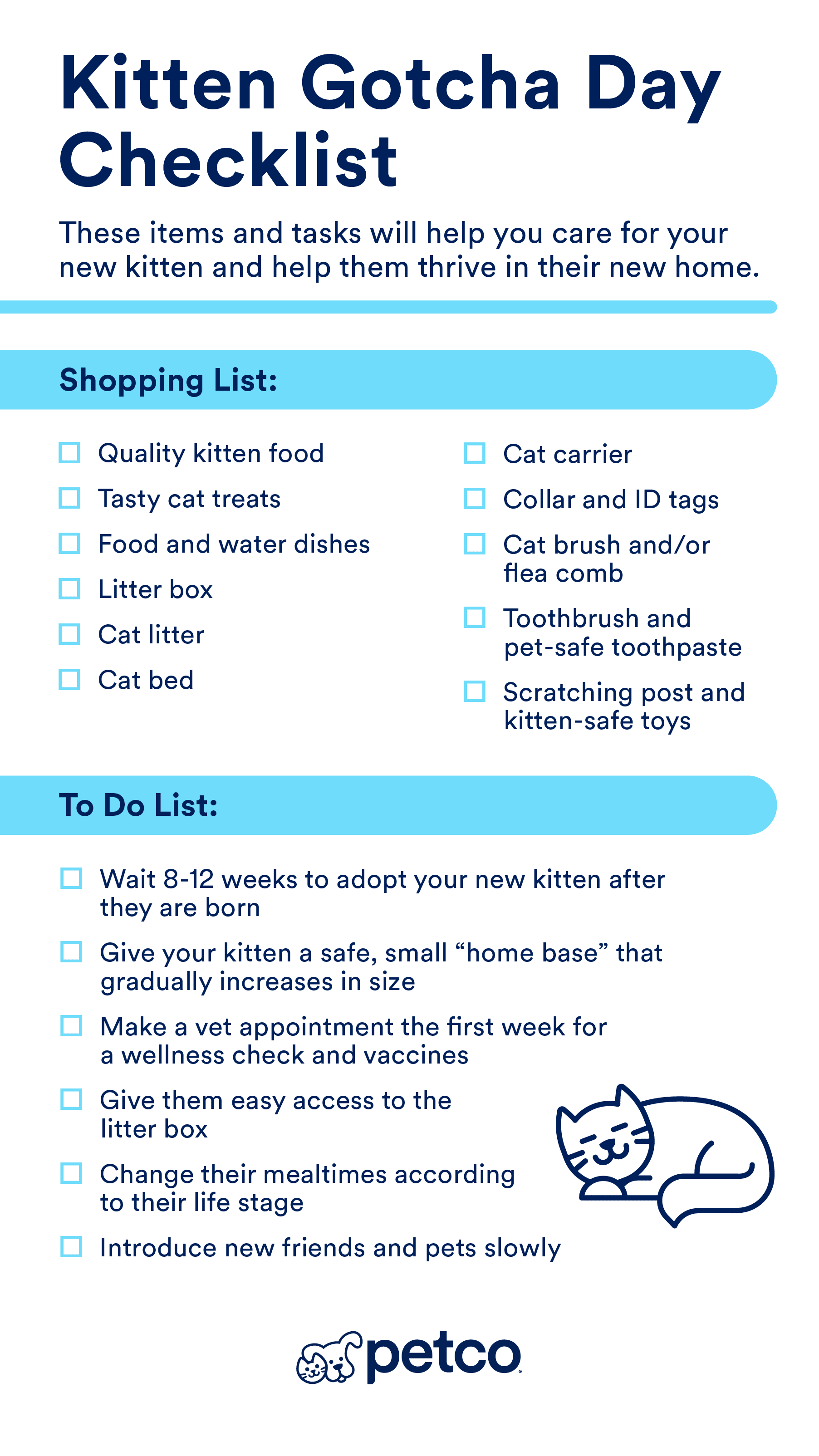Kitten Care 101: Tips for Raising a Healthy Kitten
Published On May 26th, 2025
Updated On May 28th, 2025

Reviewed By Petco’s Animal Care, Education and Compliance (ACE) Team
Education and Compliance (ACE) Team


The first few months of a kitten’s life are incredibly important for shaping their emotional, social and physical well-being. The experiences they have early on will help lay the foundation for the happy, healthy cat they’ll grow up to be. Whether you’re a first-time cat parent or a kitten parent who needs a refresher, learning to provide the right care from the beginning of your new relationship can make all the difference.
Kitten Adoption
When is a kitten ready to leave their mother?
Most kittens are ready to leave their mom once they’re fully weaned, which usually happens around 8 weeks of age. Most states require initial vaccinations at this stage, before adoption occurs. Some shelters wait 12 weeks to allow the mother extra time to socialize her babies. Depending on your situation, you might be adopting a kitten at that age or a little older from a shelter or rescue. No matter how old they are when they come home, however, those first few weeks with you are key to helping your kitten feel safe, build confidence and set the stage for a lifetime of health and happiness.
How to Prepare Your Home for a New Kitten
Preparing your home for a new kitten means more than just gathering supplies (more on that, below!)—it requires creating a safe, nurturing environment that allows your new family member to explore and grow with confidence. Thoughtful preparation ensures that you and your kitten can focus on building a strong, trusting bond without any unnecessary stress along the way.
Make your home safe for your kitten by blocking small areas
One of the most important steps in welcoming a kitten into your home is to look at your home from their sight lines and access. Tiny kittens are naturally curious and will want to investigate every nook and cranny. Close off or block any small gaps where a kitten could become trapped. Also remove access to any household items that could put a curious kitty at risk, such as window blinds, cords, hot surfaces and plants that are hazardous to cats. You can, however, purchase Cat Grass and or Catnip in moderation.

New Kitten Checklist
Back to those supplies. It’s best to have these items before your kitten joins your family so you can introduce them to everything immediately on arrival. They are:
- Quality kitten food
- Kitten treats
- Food and water dishes
- Litter box and cat litter
- Cat bed
- Cat carrier
- Collar and ID tags
- Cat brush and/or flea comb
- Toothbrush and pet-safe toothpaste
- Scratching post and kitten-safe toys
Kittens Love Quiet: Make a “Home Base”
Use these items to create a quiet, secure space where your kitten can settle in and adjust to their new environment. This can be an enclosed room or an area closed off with a pet gate. This "home base" should be free from other pets, and young children should only enter under adult supervision. If you have other pets, visually block the gate view from prying eyes for the first few days. Equip the area with a litter box, food and water dishes, cozy bedding, a scratching post and a toy or two for fun and mental stimulation. Be sure to place the food and water bowls at a comfortable distance from the litter box to keep everything clean and inviting.
The Scoop on Poop: How to Set Up Your Kitten’s Litter Box
If you’re adopting your kitten from a shelter, it’s likely they have already been exposed to a litter box. If your kitten leaves you presents elsewhere at first, it can help to pick up your kitten and place them in the box to show them that’s where they are supposed to go.
Additionally, it’s a good idea to use an open litter box, at least at first. This lets you confirm they are properly eliminating as part of their adjustment. Just like humans, some kittens prefer privacy when doing their business. If you see your kitty go in the box, give them some space, then check the box later. If a covered box is your preferred style, you can introduce that later.
When your kitten “graduates” out of the home base area, you might opt for multiple litter boxes depending on the size and layout of your home and whether your kitten is a solo cat or is joining a multi-cat household. Read our related articles to learn more about how to train a kitten to use the litter box.
How Much Will My Kitten Sleep?
If you’ve ever had a kitten, you know they like to play hard and sleep hard. In fact, young kittens often sleep 16-20 hours a day. So “paws” for reflection when selecting a bed and deciding where to put it. You’ll want something comfortable and size-appropriate; bonus for one with a removable cover you can wash. Like litter boxes, having more than one bed can be a good idea when your cat has access to more of the house.
What to Feed Your Kitten
It’s easy to think of kittens as tiny cats, but they have totally different nutritional needs. Growing kittens need special food packed with extra nutrients to support their rapid development. Most vets recommend sticking with a kitten-specific formula until they turn 1 year old. If you can, ask the shelter or previous pet parent for a week's supply of the food your kitten has been eating. Keeping them on the same diet for a bit can help with both digestion and familiarity.
While it’s always a good idea to confirm your kitten’s specific needs with your vet, here are some guidelines:
- From weaning to 6 months: Feed wet food three to four times a day or leave out dry kibble for your kitten to nibble on whenever they’re hungry.
- 6 to 9 months: Growth slows down, so watch their portions to avoid overfeeding.
- 9 to 12 months: Start transitioning to adult cat food and keep an eye on their weight. At the 1-year mark, you officially have a cat!
If you want to switch your kitten’s food, do so slowly—mix a little of the new food into the old, adding more each day over 7 to 10 days. Some kittens prefer kibble to wet food. This is fine, but keep in mind that kibble is a drier formula so offers less hydration.
Speaking of hydration, constant access to fresh water is a must. Some kittens are happy with a standard bowl, but others prefer the stream and movement of a fountain. Like people and their favorite coffee mugs, kittens have preferences, so it’s worth trying a couple of options to see what they like best.
BTW, forget the old cartoon image of cats drinking milk—most kittens can’t digest dairy properly, and it can cause diarrhea (no fun for either of you)!
Introducing your kitten to new people, places and things
A well-socialized kitten is a happy kitten. During the early stages, expose your kitten to new people and experiences, but don’t force interactions. The more your kitten sees these as opportunities instead of chores, the more enjoyable the process will be.
Think of socialization like the Twilight Zone: “a dimension not only of sight and sound but of mind.” Introduce your kitten to new sights (people of different genders, sizes, etc. with various accessories) and sounds (dryers can be scary!) for their peace of mind.
Encourage your kitten’s nature to learn and play:
Let your kitten explore at their own pace and introduce new objects and experiences without fanfare; they are just part of life and nothing to be nervous about. After your kitten has moved on from their home base, slowly expose them to different rooms with different noises, furniture and flooring.
Use boundaries with friends and family:
When introducing your kitten to family members and visiting friends, step in like a momma cat to protect your kitten from becoming overstimulated or overwhelmed. Everyone will want to pick up and cuddle your new fur baby, but it's important to let the kitten approach and interact on their own terms. When handling your kitten, let everyone know the proper technique and time frame, because overhandling your kitten can stress them out. Gently and securely pick up the kitten, supporting their torso and hind legs; do not squeeze. Start with 5-10 minutes per handling session—not per person if you have multiple visitors.
Make sure everyone stays consistent with the rules. For example, if nibbling on jewelry isn’t allowed, Grandma—no matter how much she adores her grandkitten—needs to follow the same guidelines to avoid confusing your kitten.
If your kitten does become overwhelmed, let them retreat to that home base.
Introducing kittens to other pets
It’s important to help your kitten socialize with other family pets, but hold off until kitty has received all their vaccinations. When everyone’s ready, start the introductions visually through the gate, then under direct supervision.
Kitten behavior & training
Learning about your kitten’s natural behaviors is the first step in recognizing, then curbing, any unwanted ones:
Establish acceptable behaviors during playtime:
Playtime is a great time to train your kitten. A young kitten will use their mouth to explore the world, including your hands. Mouth play shouldn’t be discouraged, but kitty does need to know what items are off-limits. Gently redirect them—and their teeth—to shift the biting behavior to an appropriate target, like toys. It is up to you to teach your kitten through both words and actions. Don’t yell, but firmly say “no” when kitty needs correcting. Give your kitten toys instead, or a scratching pad or post if your furniture is getting an unwanted makeover. Be patient: No matter how smart your little fluffball is, this type of training isn’t “one and done;” it needs regular reinforcement.
Kitten nail trims & baths
Yep, even kittens need help grooming sometimes!
Part of training is getting your kitten used to being handled, not just for petting but for brushing and nail trims. Use an appropriate brush for a kitten’s floof, knowing that a Maine Coon’s coat will need something sturdier than a British Shorthair’s. Keep a high-value treat just for post-grooming so the kitten sees being brushed as something enjoyable.
Does my kitten need a bath?
While cats are known for being predominantly self-grooming, all feline friends need help now and then. While you probably won’t need to full-on bathe a kitten unless they get into something funky, you may need to spot clean. For example, to get rid of any eye goopies, take a warm, damp washcloth or cotton ball to gently swipe a kitten’s eyes once or twice a day. Pet wipes can also be helpful for a quick refresh of the coat, making sure to use unscented ones or wipes for sensitive skin.
Remember, cats are not small dogs and should not use any dog-specific grooming supplies you may already have on hand for a resident pup. For the other end of your kitten, use either a warm washcloth or sensitive wipe if any dingleberries hold on to the fur after potty time.
When should my kitten see the vet?
Kittens should see the doctor more often than adult cats
One of the first things you should do after bringing your new kitten home is schedule a health check—ideally within the first week. During this initial visit, your vet will examine your kitten for parasites, check for any underlying health concerns and administer the first round of vaccinations if they haven't already been given.
It's a perfect opportunity to ask questions about nutrition, behavior and general care. Think of this first appointment as the start of a lifelong partnership with your veterinary team.
Adult cats should see the vet annually
Kittens require several vet visits in their first year to complete their vaccination series and ensure they're developing properly. As they grow older, adult cats typically need annual checkups. Staying consistent with vet appointments will help catch any potential health issues early and keep your cat feeling their best.
Daily weight checks are another smart move during the early months. Monitoring your kitten’s growth will help you spot any concerns, such as worms or other illnesses, before they become serious problems. If you're unsure what healthy growth looks like, refer to a kitten development guide or ask your vet for benchmarks to follow.
Make sure your kitten stays up to date on vaccinations, parasite prevention and any other recommendations your vet provides, including spaying or neutering when the time is right. Your veterinarian can offer advice tailored specifically to your kitten’s needs, setting them up for a long, healthy life. Petco vets offer comprehensive, easy-to-follow care guidelines for new pets. You can also make use of new pet offers by visiting your local Vetco Total Care or make use of a mobile vaccinations clinic near you!
Also, don’t forget to have them microchipped. Even indoor cats and kittens can get out and lost, and a microchip greatly increases your chances of being reunited.
Conclusion
If you take the time to prepare your home for your new kitten, you’ll be off to a great start. Petco has everything you need to help create a lifetime of wonderful memories and experiences with your new kitten!
Related Articles
Related Questions
Sponsored
Two Easy Ways to Start Earning Rewards!
Become a member today!Members-only pricing and offers, personalized care notifications, Vital Care points back on every purchase and more!Become a credit card member today!
Earn 2X Pals Rewards points at Petco
when you use Petco Pay!APPLY NOWLearn More About Petco Pay Benefits



